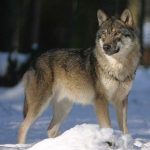Coyotes are fascinating creatures that have long been a part of North American folklore and culture. These medium-sized wild dogs are known for their intelligence, adaptability, and unique behavior. Despite being commonly misunderstood and feared, coyotes play an important role in maintaining the balance of ecosystems and are an essential part of the food chain.

One interesting fact about coyotes is that they are incredibly adaptable animals. They can survive in a wide range of habitats, from deserts to forests to cities. In fact, coyotes are known to thrive in urban areas, where they can find plenty of food and shelter. They are also highly intelligent and resourceful, using their wits to outsmart predators and find food in even the most challenging environments.
Another fascinating fact about coyotes is that they are part wolf. In fact, coyotes and wolves share a common ancestor and can interbreed to create hybrid offspring known as coywolves. Coywolves have become increasingly common in North America, particularly in areas where wolves have been hunted to near extinction. Despite their genetic similarities, coyotes and wolves have distinct differences in behavior, appearance, and vocalizations.
Basic Facts About Coyotes

Coyotes are wild canines that are native to North America. They are known for their adaptability and intelligence, which has enabled them to thrive in a variety of different environments. Here are some basic facts about coyotes:
Physical Characteristics
Coyotes are typically gray or reddish-brown in color with a bushy tail that is often black-tipped. They have a pointed snout and upright ears that are always alert for danger. Coyotes are smaller than wolves, but larger than foxes, and they typically weigh between 20-50 pounds. They are fast runners and can reach speeds of up to 40 miles per hour.
Habitat
Coyotes are found throughout North America, from Alaska to Panama. They are highly adaptable and can live in a variety of different habitats, including forests, deserts, grasslands, and even urban areas. Coyotes are social animals and live in family groups called packs. They den in burrows or hollow logs, and they are active both during the day and at night.
Diet
Coyotes are opportunistic hunters and scavengers. They will eat almost anything they can find, including small mammals, birds, insects, and even fruit and vegetables. They are also known for their ability to hunt larger prey, such as deer, when they work together in packs. Coyotes are important predators in many ecosystems and help to control populations of rodents and other small mammals.
Overall, coyotes are fascinating animals that play an important role in the ecosystems they inhabit. Their adaptability and intelligence have enabled them to thrive in a variety of different environments, and their unique physical characteristics make them a distinctive and recognizable species.
Coyote Behavior
Coyotes are fascinating animals that have adapted to living in a variety of environments. They are highly adaptable and can thrive in small patches of woods just outside the city limits. Coyote behavior can vary, and they often have many interactions with humans. In this section, we will explore their social structure, communication methods, and breeding habits.
Social Structure
Coyotes are social animals that live in family groups known as packs. These packs are typically made up of a mated pair and their offspring. The size of the pack can vary depending on the availability of food and other resources. In areas with abundant food, packs may be larger and include extended family members.
Communication Methods
Coyotes use a variety of communication methods to interact with each other and other animals. They communicate through vocalizations such as howls, yips, and barks. These vocalizations can convey information about their location, social status, and reproductive status. They also use body language, such as tail wagging, ear position, and facial expressions, to communicate with each other.
Breeding Habits
Coyotes breed once a year, typically in late winter or early spring. Mating pairs will remain together for several years and may produce offspring for several breeding seasons. Females give birth to litters of 4-7 pups, which are born blind and helpless. The pups are cared for by both parents and will remain with the pack for up to a year before dispersing to find their own territory.
Overall, coyotes are fascinating animals with complex social structures, communication methods, and breeding habits. Understanding these behaviors can help us coexist with these animals in a safe and respectful manner.
Coyotes and Humans
Coyotes are known to be adaptable and resilient animals that can thrive in various environments, including urban areas and rural landscapes. Here are some interesting facts about coyotes and their interactions with humans.
Coyotes in Urban Areas
Coyotes have been spotted in many urban areas across the United States and Canada, including Los Angeles, Chicago, and Toronto. These animals are often attracted to cities because of the abundance of food and shelter available. They are opportunistic feeders and will eat anything from garbage to small pets.
To prevent conflicts with coyotes in urban areas, it is important for residents to take certain precautions. These include securing garbage cans, keeping pet food indoors, and not leaving pets unattended outside. Coyotes are generally not a threat to humans, but it is important to keep a safe distance and not to feed or approach them.
Coyotes in Native American Culture
Coyotes have played an important role in the mythology and folklore of many Native American cultures. In some traditions, coyotes are seen as tricksters who use their cunning and intelligence to outsmart their enemies. In other traditions, coyotes are revered as powerful and wise animals that have a special connection to the spiritual world.
Coyotes are also associated with the moon in many Native American cultures. Some tribes believe that coyotes howl at the moon to communicate with the spirit world, while others believe that the howling of coyotes is a sign of impending danger or death.
Overall, coyotes are fascinating animals with a rich history and cultural significance. By learning more about these animals and taking certain precautions, humans can coexist with coyotes in a safe and respectful manner.
Coyote Conservation

Threats to Coyote Populations
Coyotes are not considered an endangered species, but their populations are threatened by human activities such as habitat destruction, hunting, and trapping. In some areas, coyotes are seen as pests and are actively hunted or trapped to control their numbers. This can lead to a decrease in genetic diversity and an increase in the number of coyotes with negative traits such as aggression.
Conservation Efforts
Several organizations are working to conserve coyote populations and protect their habitats. The Coyote Project, for example, is a non-profit organization that aims to promote coexistence between humans and coyotes by providing education and resources to communities. The project also conducts research on coyote behavior and ecology to better understand their needs and how to protect them.
Another organization, the National Wildlife Federation, advocates for policies that protect coyote habitats and limit hunting and trapping. The organization also promotes the use of non-lethal methods for controlling coyote populations, such as hazing and deterrents.
Overall, conservation efforts for coyotes focus on protecting their habitats and promoting coexistence between humans and coyotes. By understanding the needs of these animals and working to protect them, we can help ensure that they continue to thrive in the wild.
Scientific Study of Coyotes

Coyotes have been the subject of many scientific studies over the years. Here are some key research findings and unresolved questions:
Key Research Findings
- Behavioral Ecology: Coyotes are highly adaptable and have been able to successfully colonize many different habitats, including urban areas and islands. They are also known for their complex social behavior, which includes cooperative hunting and vocal communication.
- Genetics: Coyotes are closely related to wolves and dogs, and there is ongoing research into the genetic relationships between these species. For example, scientists have found evidence of hybridization between coyotes and wolves in some areas.
- Diet: Coyotes are opportunistic feeders and will eat a wide variety of prey, including small mammals, birds, reptiles, and even insects. They are also known to scavenge from human sources, such as garbage cans and roadkill.
Unresolved Questions
- Population Dynamics: Despite their success as a species, there is still much to learn about the factors that influence coyote populations. For example, scientists are still trying to understand the impact of hunting and trapping on coyote populations, as well as the effects of habitat fragmentation and urbanization.
- Communication: While much is known about the vocalizations of coyotes, there is still much to learn about the nuances of their communication. For example, scientists are still trying to understand the meaning behind different vocalizations, as well as the role that body language and scent play in communication between individuals.
- Disease Ecology: Coyotes are known to carry a variety of diseases, including rabies and distemper. However, there is still much to learn about the impact of these diseases on coyote populations, as well as the role that coyotes play in the transmission of diseases to other species.
Interesting Coyote Trivia
Record-Breaking Coyotes
Coyotes are known for their incredible adaptability and resourcefulness. They are found in almost every type of environment, from deserts to forests to urban areas. Coyotes are also known for their impressive physical abilities. In fact, the coyote holds the record for the fastest land speed of any North American mammal in its weight class. According to Facts.net, an adult coyote can reach speeds of up to 70 km/h while pursuing its prey.
Coyotes are also known for their vocalizations. They have a wide range of calls, from barks and howls to yips and yelps. Coyotes are so vocal that they have been nicknamed the “song dogs” of the animal world. In fact, a group of coyotes is called a “chorus” or a “pack”.
Coyotes in Popular Culture
Coyotes have long been a part of Native American folklore and mythology. They are often depicted as tricksters and shape-shifters. Coyotes have also played a role in American popular culture. In the 1940s and 1950s, the cartoon character Wile E. Coyote became a beloved icon of American animation.
Coyotes have also been featured in literature and film. In the novel “The Call of the Wild” by Jack London, a pack of coyotes is described as “a chorus of wolves”. In the film “Dances with Wolves”, the main character John Dunbar befriends a wolf and a coyote.
Overall, coyotes are fascinating creatures with a rich history and many unique traits. From their impressive physical abilities to their vocalizations and cultural significance, coyotes are truly one of a kind.
What are Some Similarities and Differences Between Coyotes and Giant Pandas?
Coyotes are known for their adaptability in various habitats, similar to giant pandas who can live in different types of forests. However, coyotes are carnivorous while giant pandas are herbivores. Interestingly, giant pandas have a thumb-like bone that helps them hold bamboo, an interesting fact about giant pandas.
Frequently Asked Questions
What are some common myths about coyotes?
Coyotes often get a bad reputation due to common myths and misconceptions. One of the most common myths is that coyotes are dangerous predators that pose a significant threat to humans. However, coyotes are generally timid and avoid human contact whenever possible. Another myth is that coyotes only live in rural areas, but they can also be found in urban and suburban areas.
How fast can coyotes run and how far can they travel?
Coyotes are known for their agility and speed. They can run up to 43 mph when pursuing prey or fleeing danger, and they are capable of traveling long distances. According to Facts.net, coyotes can travel up to 100 miles in a single night.
What do coyotes eat and how do they hunt?
Coyotes are opportunistic feeders and will eat almost anything they can find. Their diet consists of small mammals, such as rodents and rabbits, as well as birds, insects, and even fruits and vegetables. They are also known to scavenge for food and will eat carrion. Coyotes hunt alone or in pairs, and they use their keen senses to locate prey.
What are some unique physical features of coyotes?
Coyotes have several unique physical features that set them apart from other canids. They have a bushy tail that they use for balance and communication, and their fur varies in color from gray to reddish-brown. Coyotes also have pointed ears and a long, narrow snout that helps them hunt and locate prey.
What is the lifespan of a coyote?
The lifespan of a coyote varies depending on several factors, such as habitat and food availability. In the wild, coyotes typically live for 6 to 8 years, but they can live up to 14 years in captivity.
What are some interesting behaviors of coyotes?
Coyotes are social animals that live in family groups called packs. They use a variety of vocalizations, such as howls, barks, and yips, to communicate with each other. Coyotes are also known for their playful behavior, and they enjoy running, chasing, and wrestling with each other.










